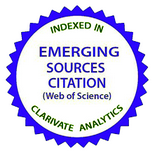Photoreactions of Macrocyclic Dyes on (1010) Wurtzite Surface – Interplay Between Conformation and Electronic Effects
DOI:
https://doi.org/10.15407/ujpe64.1.63Keywords:
macrocyclic dyes, wurzite, electron transfer, DFTAbstract
Macrocyclic dyes such as phthalocyanine and porphyrin molecules are modeled on (1010) wurzite surfaces using the DFT and molecular dynamics approaches. It is found that the single dye anchored on the wurtzite surface stabilizes in an inclined geometry with its core facing the surface at a tilting angle of ca 60∘. The tilting of the dye relative to the crystal surface has a dual effect on the charge transfer from a chromophore to the semiconductor. Increasing the tilting angle leads to a stronger coupling between the lowest level of the semiconductor conduction band and dye’s LUMO, thus raising the tunneling probability of the electron injection. By contrast, the electrostatic interaction between units upon the tilting of macrocycles results in a lowering of the molecule LUMO level with respect to the conduction band minimum of the wurzite crystal, which may hinder the electron transfer. The type of a linker and peripheral substituents significantly affect the mutual conformation of the moieties, and their proper choice can facilitate the photoinduced charge transfer reactions.
References
P. Docampo, S. Guldin, T. Leijtens, N. Noel, U. Steiner, H. Snaith. Lessons learned: From dye-sensitized solar cells to all-solid-state hybrid devices. Adv. Mat. 26, 4013 (2014). https://doi.org/10.1002/adma.201400486
N. Kaura, M. Singh, D. Pathak, T. Wagner, J. Nunzid. Organic materials for photovoltaic applications: Review and mechanism. Synthetic Metals 190, 20 (2014). https://doi.org/10.1016/j.synthmet.2014.01.022
V. Golovanov, V. Smyntyna, G. Mattogno, S. Kasiulis, V. Lantto. Oxygen interaction of CdS-based gas sensors with different stoichiometric composition. Sensors and Actuators B 26–27, 108 (1995).
S. Dag, S. Wang, L. Wang. Large surface dipole moments in ZnO nanorods. Nano Letters 11, 2348 (2011). https://doi.org/10.1021/nl200647e
S. V. Kilina, D.S. Kilin, O.V. Prezhdo. Breaking the phonon bottleneck in PbSe and CdSe quantum dots: Time-domain density functional theory of charge carrier relaxation. ACS Nano 3 (1), 93 (2009). https://doi.org/10.1021/nn800674n
J.M. Azpiroz, F. De Angelis. Ligand induced spectral changes in CdSe quantum dots. ACS Appl. Mater. Interfaces 7 (35), 19736 (2015). https://doi.org/10.1021/acsami.5b05418
K. Virkki, H. Hakola, M. Urbani, L. Tejerina, M. Ince, M. Diaz, T. Torres, V. Golovanova, V. Golovanov, N. Tkachenko. Photoinduced electron injection from zinc phthalo-cyanines into zinc oxide nanorods – Aggregation effects. J. Phys. Chem. C 121 (17), 9594 (2017). https://doi.org/10.1021/acs.jpcc.7b01562
V.V. Golovanov, B.V. Nazarchuk, V.V. Golovanova, N.V. Tkachenko, T.T. Rantala. Effects of orientation at the phthalocyanine–CdSe interface on the electron transfer characteristics. Phys. Chem. Chem. Phys. 19, 10511 (2017). https://doi.org/10.1039/C7CP00833C
M. Niskanen, M. Kuisma, O. Cramariuc, V. Golovanov, T. Hukka, N. Tkachenko, T.T. Rantala. Porphyrin adsorbed on the (10? 10) surface of the wurtzite structure of ZnO – conformation induced effects on the electron transfer characteristics. Phys. Chem. Chem. Phys. 15 (40), 17408 (2013). https://doi.org/10.1039/c3cp51685g
H. Matsuzaki, T. Murakami, N. Masaki, A. Furube, M. Kimura, S. Mori. Dye aggregation effect on interfacial electron-transfer dynamics in zinc phthalocyanine-sensitized solar cells. J. Phys. Chem. C 118, 17205 (2014). https://doi.org/10.1021/jp500798c
L. Tejerina, M. Martinez-Diaz, M. Nazeeruddin, T. Torres. The influence of substituent orientation on the photovoltaic performance of phthalocyanine-sensitized solar cells. Chem. – Eur. J. 22, 4369 (2016). https://doi.org/10.1002/chem.201600166
H. Imahori, S. Kang, H. Hayashi, M. Haruta, H. Kurata, S. Isoda, S. Canton, Y. Infahsaeng, A. Kathiravan, T. Pascher, P. Chabera, A. Yartsev, V. Sundstrom. Photoinduced charge carrier dynamics of Zn-porphyrin-TiO2 electrodes: The key role of charge recombination for solar cell performance. J. Phys. Chem. A 115, 3679 (2011). https://doi.org/10.1021/jp103747t
M. Griffith, M. James, G. Triani, P. Wagner, G. Wallace, D. Officer. Determining the orientation and molecular packing of organic dyes on a TiO2 surface using X-ray reflectometry. Langmuir 27, 12944 (2011). https://doi.org/10.1021/la202598c
S. Ye, A. Kathiravan, H. Hayashi, Y. Tong, Y. Infahsaeng, P. Chabera, T. Pascher, A. Yartsev, S. Isoda, H. Imahori, V. Sundstr?om. Role of adsorption structures of Zn-porphyrin on TiO2 in dye-sensitized solar cells studied by sum frequency generation vibrational spectroscopy and ultrafast spectroscopy. J. Phys. Chem. C 117, 6066 (2013). https://doi.org/10.1021/jp400336r
V. Golovanov, V. Golovanova, T.T. Rantala. Thermal desorption of molecular oxygen from SnO2 (110) surface: Insights from first-principles calculations. J. Chem. Phys. Solids 89, 15 (2016). https://doi.org/10.1016/j.jpcs.2015.10.010
V. Golovanov, T. Kortelainen, T.T. Rantala. Stability of siloxane couplers on pure and fluorine doped SnO2 (110) surface: a first principles study. Surf. Sci. 604 (19–20), 1784 (2010). https://doi.org/10.1016/j.susc.2010.07.006
N. Ozcan, T. Kortelainen, V. Golovanov, T.T. Rantala, J. Vaara. Electron spin resonance parameters of bulk oxygen vacancy in semiconducting tin dioxide. Phys. Rev. B 81 (23), 235202 (1–10) (2010).
Y. Siao, P. Liu, Y. Wu. Ab initio study of atomic hydrogen on ZnO surfaces. Appl. Phys. Expr. 4, 125601 (2011). https://doi.org/10.1143/APEX.4.125601
V. Smyntyna, V. Golovanov, S. Kasiulis, G. Mattogno, G. Righini. Influence of chemical composition on sensitivity and signal reproducibility of CdS sensors of oxygen. Sensors and Actuators B 24–25, 628 (1995). https://doi.org/10.1016/0925-4005(95)85138-0
M. Arvani, K. Virkki, F. Abou-Chahine, A. Efimov, N.V. Tkachenko, D. Lupo. Photoinduced hole transfer in QD–phthalocyanine hybrids. Phys. Chem. Chem. Phys. 18, 27414 (2016). https://doi.org/10.1039/C6CP04374G
N. Moreira, A. da Rosa, T. Frauenheim. Covalent functionalization of ZnO surfaces: a density functional tight binding study. Appl. Phys. Lett. 94, 193109 (2009). https://doi.org/10.1063/1.3132055
BAND2014, SCM, Theoretical Chemistry, Vrije Universiteit, Amsterdam, The Netherlands, http://www.scm.com.
J. Perdew, A. Ruzsinszky, G. Csonka, O. Vydrov, G. Scuseria, L. Constantin, X. Zhou, K. Burke. Restoring the density-gradient expansion for exchange in solids and surfaces. Phys. Rev. Lett. 102, 039902 (2009). https://doi.org/10.1103/PhysRevLett.102.039902
M. Kuisma, J. Ojanen, J. Enkovaara, T.T. Rantala. Kohn-Sham potential with discontinuity for band gap materials. Phys. Rev. B 82, 115106 (2010). https://doi.org/10.1103/PhysRevB.82.115106
S. Grimme, J. Antony, S. Ehrlich, H. Krieg. A consistent and accurate ab initio parametrization of density functional dispersion correction (DFT-D) for the 94 elements H–Pu. J. Chem. Phys. 132, 154104 (2010). https://doi.org/10.1063/1.3382344
O. Ermer. Bonding Forces (Springer, 1976).
S. Mayo, B. Olafson, W. Goddard. Dreiding: A generic forcefield. J. Phys. Chem. 94, 8897 (1990). https://doi.org/10.1021/j100389a010
J. Sukegawa, C. Schubert, X. Zhu, H. Tsuji, D. Guldi, E. Nakamura. Electron transfer through rigid organic molecular wires enhanced by electronic and electron–vibration coupling. Nature Chem. 6, 889 (2014). https://doi.org/10.1038/nchem.2026
B. Pelado, F. Abou-Chahine, J. Calbo, R. Caballero, P. Cruz, J. Junquera-Hernandez, E. Orti, N. Tkachenko, F. Langa. Role of the bridge in photoinduced electron transfer in porphyrin–fullerene dyads. Chem. Eur. J. 21, 1 (2015). https://doi.org/10.1002/chem.201406514
Downloads
Published
How to Cite
Issue
Section
License
Copyright Agreement
License to Publish the Paper
Kyiv, Ukraine
The corresponding author and the co-authors (hereon referred to as the Author(s)) of the paper being submitted to the Ukrainian Journal of Physics (hereon referred to as the Paper) from one side and the Bogolyubov Institute for Theoretical Physics, National Academy of Sciences of Ukraine, represented by its Director (hereon referred to as the Publisher) from the other side have come to the following Agreement:
1. Subject of the Agreement.
The Author(s) grant(s) the Publisher the free non-exclusive right to use the Paper (of scientific, technical, or any other content) according to the terms and conditions defined by this Agreement.
2. The ways of using the Paper.
2.1. The Author(s) grant(s) the Publisher the right to use the Paper as follows.
2.1.1. To publish the Paper in the Ukrainian Journal of Physics (hereon referred to as the Journal) in original language and translated into English (the copy of the Paper approved by the Author(s) and the Publisher and accepted for publication is a constitutive part of this License Agreement).
2.1.2. To edit, adapt, and correct the Paper by approval of the Author(s).
2.1.3. To translate the Paper in the case when the Paper is written in a language different from that adopted in the Journal.
2.2. If the Author(s) has(ve) an intent to use the Paper in any other way, e.g., to publish the translated version of the Paper (except for the case defined by Section 2.1.3 of this Agreement), to post the full Paper or any its part on the web, to publish the Paper in any other editions, to include the Paper or any its part in other collections, anthologies, encyclopaedias, etc., the Author(s) should get a written permission from the Publisher.
3. License territory.
The Author(s) grant(s) the Publisher the right to use the Paper as regulated by sections 2.1.1–2.1.3 of this Agreement on the territory of Ukraine and to distribute the Paper as indispensable part of the Journal on the territory of Ukraine and other countries by means of subscription, sales, and free transfer to a third party.
4. Duration.
4.1. This Agreement is valid starting from the date of signature and acts for the entire period of the existence of the Journal.
5. Loyalty.
5.1. The Author(s) warrant(s) the Publisher that:
– he/she is the true author (co-author) of the Paper;
– copyright on the Paper was not transferred to any other party;
– the Paper has never been published before and will not be published in any other media before it is published by the Publisher (see also section 2.2);
– the Author(s) do(es) not violate any intellectual property right of other parties. If the Paper includes some materials of other parties, except for citations whose length is regulated by the scientific, informational, or critical character of the Paper, the use of such materials is in compliance with the regulations of the international law and the law of Ukraine.
6. Requisites and signatures of the Parties.
Publisher: Bogolyubov Institute for Theoretical Physics, National Academy of Sciences of Ukraine.
Address: Ukraine, Kyiv, Metrolohichna Str. 14-b.
Author: Electronic signature on behalf and with endorsement of all co-authors.

















